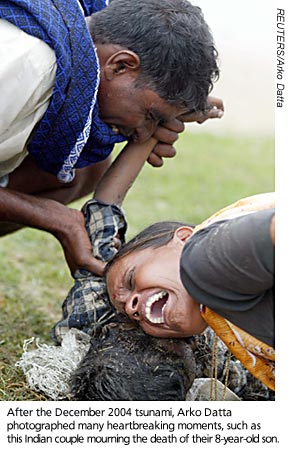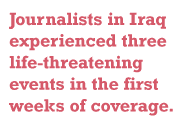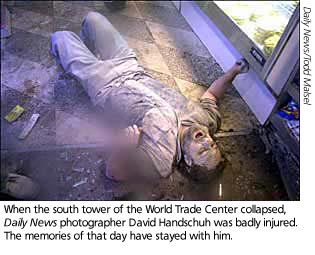Daily News photographer David Handschuh was shooting through the haze and horror of the September 11, 2001 attack on the World Trade Center when the south tower collapsed, blowing him down the block and burying him in debris. While his badly broken leg required months of recuperation, he is “still dealing with what I paid witness to that day.”
On assignment in south India after the December 2004 tsunami, Reuters photographer Arko Datta was stopped short by the sight of a young boy clinging to his dead mother. Experienced as he was in covering disasters, that awful memory lingers.
 Working for months in Iraq, New York Times reporter Jeff Gettleman felt the grinding toll of seeing bodies blown apart in the suicide bombings and violent attacks that became part of everyday life. “You have access there,” Gettleman said, “to things you shouldn’t see.” Working for months in Iraq, New York Times reporter Jeff Gettleman felt the grinding toll of seeing bodies blown apart in the suicide bombings and violent attacks that became part of everyday life. “You have access there,” Gettleman said, “to things you shouldn’t see.”
News organizations and journalism groups are beginning to widely acknowledge that many photographers, reporters, and cameramen do not come away from such trauma-filled assignments emotionally unscathed. New research, including a study released in April, found three in 10 journalists suffer post-traumatic stress after working on dangerous assignments. Depression, anxiety, alcoholism, and relationship problems have also been reported.
Media organizations have long made counseling available to staffers, but analysts say newsrooms have been slow in adopting the extensive trauma support and training long used by other “first-response” organizations such as medical care and disaster relief agencies.
Now, several large news companies say they have begun more sophisticated and proactive programs to support staffers exposed to trauma. Many of these efforts have dangerous assignments. Depression, anxiety, alcoholism, and relationship problems have also been reported. Media organizations have long made counseling available to staffers, but analysts say newsrooms have been slow in adopting the extensive trauma support and training long used by other “first-response” organizations such as medical care and disaster relief agencies.
But more can be done. These efforts have yet to spread through the entire news industry or to many parts of the world. Freelancers are often left on their own. And in a deadline-driven field, where personal detachment is considered a virtue, there is still little space in newsroom culture for journalists dealing with trauma.
Hard-drinking, swaggering, divorced war correspondents may be a common stereotype, but proof of their existence was largely anecdotal until 2002 when the American Journal of Psychiatry published a study led by Anthony Feinstein of the University of Toronto. The study of 140 combat journalists — titled “A Hazardous Profession: War, Journalists, and Psychopathology” — concluded that nearly 30 percent of the participants showed serious signs of post-traumatic stress. They were not likely to get treatment, either.
 Feinstein released a follow-up study in April that focused on journalists covering the U.S. invasion of Iraq. Collecting data in July 2003 from embedded and unilateral journalists, he concluded that a third were psychologically distressed. Using a mean, Feinstein said that participants experienced three life-threatening events in the first weeks of war coverage. Feinstein released a follow-up study in April that focused on journalists covering the U.S. invasion of Iraq. Collecting data in July 2003 from embedded and unilateral journalists, he concluded that a third were psychologically distressed. Using a mean, Feinstein said that participants experienced three life-threatening events in the first weeks of war coverage.
“Feinstein’s [2002] study was very important to this issue. There was really nothing before that,” said Santiago Lyon, director of photography at The Associated Press. Lyon, a veteran war photographer who covered conflicts in El Salvador, the Balkans, the first Gulf War, Afghanistan, and Somalia, has grappled with post-traumatic stress himself and has seen it among his staffers. “In recent years, media organizations have gotten much better at helping journalists cope with stress and trauma.”
In February, prompted by a request from a veteran war correspondent, The New York Times began a program to help journalists in the field cope more effectively. It includes trauma briefings for editors and news managers; a hotline for journalists’ families; and pre-assignment and exit briefings for all staffers working in high-risk areas.
The British Broadcasting Company, using recommendations from the British Ministry of Defense, has put its emphasis on management. A program launched in fall 2004 aims to train all BBC managers, team leaders, and editors responsible for at-risk staff to recognize when a journalist is having difficulties and offer peer support, said Dipti Patel, occupational health physician for the BBC.
 Five years ago, after the killing of Reuters correspondent Kurt Schork in Sierra Leone had deeply affected his colleagues, the news agency stepped up efforts to teach managers how to recognize and cope with trauma, according to Global Managing Editor David Schlesinger. “The main problem for us,” he said, “has been getting past the idea that journalists are tough and macho and to get them to recognize that it is OK to talk about their problems.” Schlesinger said Reuters’ staffers talk more frequently now with professional counselors and their colleagues. Five years ago, after the killing of Reuters correspondent Kurt Schork in Sierra Leone had deeply affected his colleagues, the news agency stepped up efforts to teach managers how to recognize and cope with trauma, according to Global Managing Editor David Schlesinger. “The main problem for us,” he said, “has been getting past the idea that journalists are tough and macho and to get them to recognize that it is OK to talk about their problems.” Schlesinger said Reuters’ staffers talk more frequently now with professional counselors and their colleagues.
Other organizations that have strengthened support efforts include National Public Radio, which offers counseling and time off to all journalists returning from danger zones, and the AP, which began offering staffers international access to counselors.
Addressing job-related trauma is imperative at a time when professional demands and dangers are higher than ever, Handschuh said. “There’s a cumulative effect to what we witness–and add to that the 24-hour news cycle.”
“Covering the tsunami was like going through an emotional roller-coaster,” said Datta, whose photographs of devastated south India appeared in Time, Newsweek, and The Economist. Datta said the experience did not differ much from other disasters, all of which “are difficult to cover logistically and emotionally,” but noted that he came across several scenes that stopped him in his tracks. “Having lost my mother recently, watching a particular instance of people trying to pull away a boy clinging on to his dead mother, was too painful for me.”
Iraq–where 41 journalists have been killed and 30 abducted as of April–poses basic survival risks. “Every day in Iraq, I was nostalgic for Afghanistan,” said Gettleman, of The New York Times, who covered the U.S.-led attack on Afghanistan in 2001 and the subsequent invasion of Iraq. “Even though Afghanistan had dangers, journalists were not targets.” Gettleman was abducted in Iraq and held by gunmen for a day in April 2004. “The stress that puts you and everyone working around you under is enormous,” he said.
 AP’s Lyon said the 24-hour news cycle–and the technology that has made it possible to relay news and images instantly–has exposed journalists to greater risk for longer, unbroken periods. Journalists in prior conflicts had to file from offices or other serene settings; digital photography and satellite communication now both allow and encourage them to file from the scene. Factor in the continuous news cycle, and journalists are never truly off deadline. AP’s Lyon said the 24-hour news cycle–and the technology that has made it possible to relay news and images instantly–has exposed journalists to greater risk for longer, unbroken periods. Journalists in prior conflicts had to file from offices or other serene settings; digital photography and satellite communication now both allow and encourage them to file from the scene. Factor in the continuous news cycle, and journalists are never truly off deadline.
Attitudes about trauma are slowly changing, said Roger Simpson, executive director of the Dart Center for Journalism & Trauma at the University of Washington. “A decade ago,” he said, “we sometimes met hostile responses from corporate personnel people. That almost never happens today.”
But counseling alone is not enough, Simpson said. “Management often fails to create a climate of support and respect for counseling among their journalists,” he said. And while a handful of “leaders in the industry” are promoting better trauma management, Simpson said, those practices have yet to spread throughout the news business.
Simpson said everyone in a news operation should receive training about safety and trauma, and editors should ensure that they are in touch with every journalist in a dangerous situation, as well as their families. After media workers complete assignments, a formal program to continue discussion should be made available. Dart also cautions against sending journalists back into dangerous assignments too soon.
Freelance journalists remain at particular risk. “They don’t have much support and they risk a lot in war and conflict situations,” Simpson said. “There is a huge need for this underserved group.”
Freelance journalists typically find it harder to secure affordable counseling than do staff journalists. Some freelancers can obtain counseling through their own health insurance plans, if the plans are broad enough to cover such issues. But only a handful of media organizations help freelancers cover the costs of such insurance.
Across the world, local journalists in conflict zones face extraordinary stress and personal danger. CPJ has tracked several cases in which these local journalists received help for emotional scars only after relocating to safer places. Sri Lankan journalist Dharma Lingham, whose life was threatened after he exposed human rights abuses by the Liberation Tigers of Tamil Eelam, said he noticed symptoms of psychological distress only after he left the country.
Not only do journalists suppress trauma to survive, in many of the world’s troubled places, help is simply not available. “As far as I know there is no concept of counseling for post-traumatic stress,” said Owais Aslam Ali, secretary general of the Pakistan Press Foundation. “Close family structure in our society may help a bit, but it is not a substitute for professional counseling.”
In the United States, however, work-related trauma, once mentioned in hushed tones, is being addressed more regularly in public. At its annual conference this year, Military Reporters and Editors (MRE), a U.S.-based association, will feature a panel on the subject for the first time.
The Nieman Foundation has also chosen trauma as the theme of its two-day conference this October. “There is a great responsibility to learn from the research out there,” said Stefanie Friedhoff, a freelance journalist and organizer of the conference co-sponsored by the Dart Center. “If almost a third [of journalists] come back with trauma, we have to do something about it.”
|